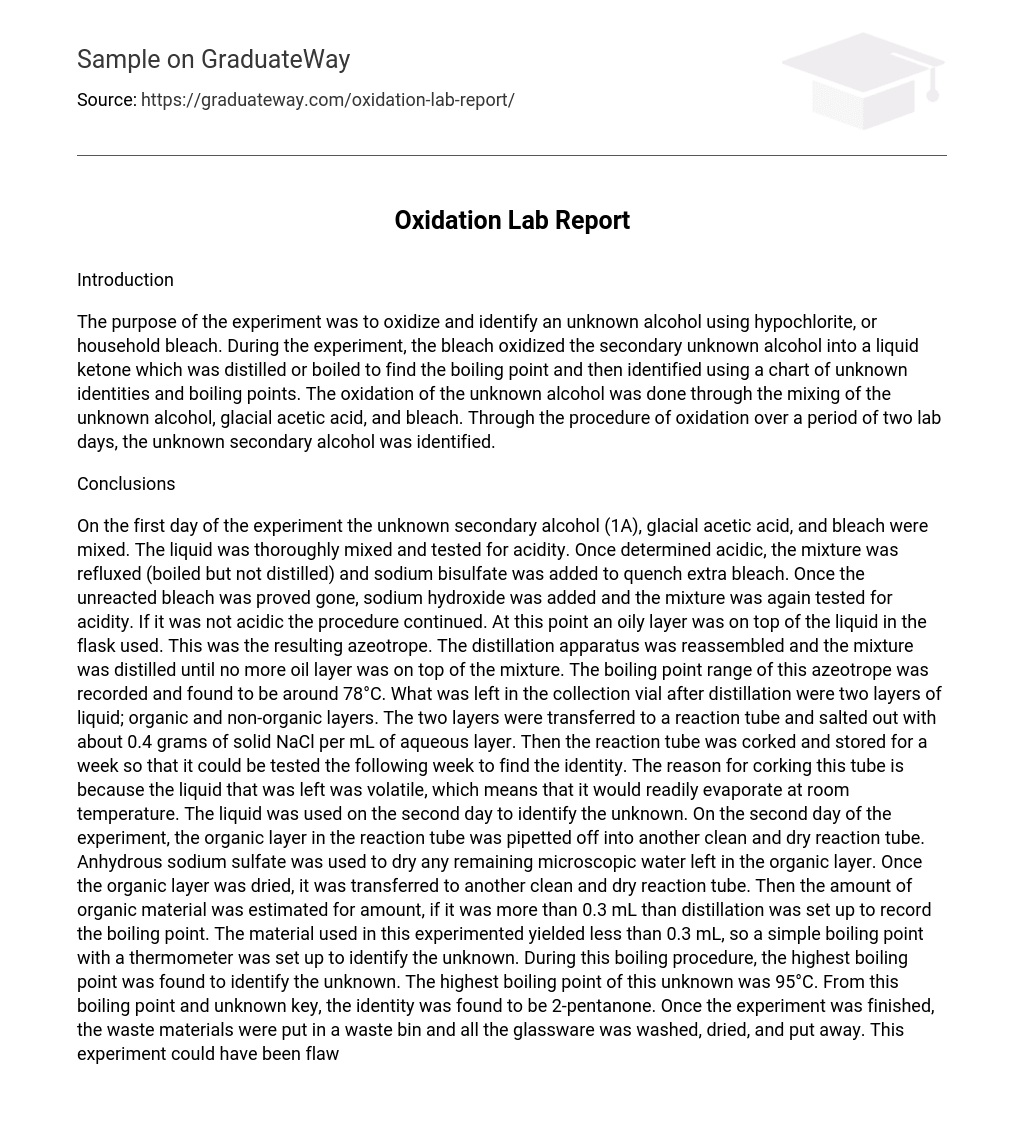Introduction
The purpose of the experiment was to oxidize and identify an unknown alcohol using hypochlorite, or household bleach. During the experiment, the bleach oxidized the secondary unknown alcohol into a liquid ketone which was distilled or boiled to find the boiling point and then identified using a chart of unknown identities and boiling points. The oxidation of the unknown alcohol was done through the mixing of the unknown alcohol, glacial acetic acid, and bleach. Through the procedure of oxidation over a period of two lab days, the unknown secondary alcohol was identified.
Conclusions
On the first day of the experiment the unknown secondary alcohol (1A), glacial acetic acid, and bleach were mixed. The liquid was thoroughly mixed and tested for acidity. Once determined acidic, the mixture was refluxed (boiled but not distilled) and sodium bisulfate was added to quench extra bleach. Once the unreacted bleach was proved gone, sodium hydroxide was added and the mixture was again tested for acidity. If it was not acidic the procedure continued. At this point an oily layer was on top of the liquid in the flask used. This was the resulting azeotrope. The distillation apparatus was reassembled and the mixture was distilled until no more oil layer was on top of the mixture. The boiling point range of this azeotrope was recorded and found to be around 78°C. What was left in the collection vial after distillation were two layers of liquid; organic and non-organic layers. The two layers were transferred to a reaction tube and salted out with about 0.4 grams of solid NaCl per mL of aqueous layer. Then the reaction tube was corked and stored for a week so that it could be tested the following week to find the identity. The reason for corking this tube is because the liquid that was left was volatile, which means that it would readily evaporate at room temperature. The liquid was used on the second day to identify the unknown. On the second day of the experiment, the organic layer in the reaction tube was pipetted off into another clean and dry reaction tube. Anhydrous sodium sulfate was used to dry any remaining microscopic water left in the organic layer. Once the organic layer was dried, it was transferred to another clean and dry reaction tube. Then the amount of organic material was estimated for amount, if it was more than 0.3 mL than distillation was set up to record the boiling point. The material used in this experimented yielded less than 0.3 mL, so a simple boiling point with a thermometer was set up to identify the unknown. During this boiling procedure, the highest boiling point was found to identify the unknown. The highest boiling point of this unknown was 95°C. From this boiling point and unknown key, the identity was found to be 2-pentanone. Once the experiment was finished, the waste materials were put in a waste bin and all the glassware was washed, dried, and put away. This experiment could have been flawed through many ways. The experiment could have been flawed through the incorrect amounts of solutes and solvents. This is easily fixed by measuring and re-measuring the liquids used. Also, the experiment could have had errors through incorrect times of reflux and distillation. This could be fixed by more observant behavior during the reflux and distillation. Another way errors could occur within the experiment was if a bad cork was used to cap the reaction tube with volatile liquids. This would have caused the experiment to lose all the liquid needed for identification the on the second day. However, this particularly error did not occur, and the experiment proceeded as well as understood.





